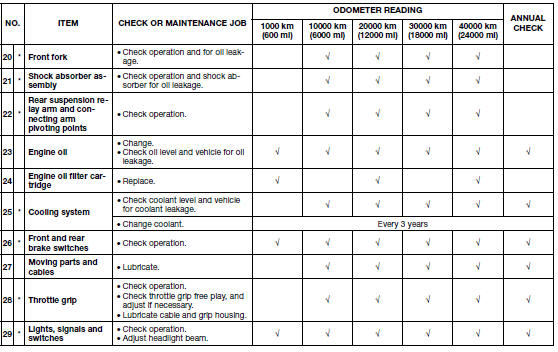 Yamaha Tracer MT09TRA - Owner's Manual > Periodic maintenance and adjustment
Yamaha Tracer MT09TRA - Owner's Manual > Periodic maintenance and adjustment
Periodic inspection, adjustment, and lubrication will keep your vehicle in the safest and most efficient condition possible. Safety is an obligation of the vehicle owner/operator. The most important points of vehicle inspection, adjustment, and lubrication are explained on the following pages.
The intervals given in the periodic maintenance charts should be simply considered as a general guide under normal riding conditions. However, depending on the weather, terrain, geographical location, and individual use, the maintenance intervals may need to be shortened.
WARNING
Failure to properly maintain the vehicle or performing maintenance activities incorrectly may increase your risk of injury or death during service or while using the vehicle. If you are not familiar with vehicle service, have a Yamaha dealer perform service.
WARNING
Turn off the engine when performing maintenance unless otherwise specified
- A running engine has moving parts that can catch on body parts or clothing and electrical parts that can cause shocks or fires.
- Running the engine while servicing can lead to eye injury, burns, fire, or carbon monoxide poisoning - possibly leading to death.
WARNING
Brake discs, calipers, drums, and linings can become very hot during use. To avoid possible burns, let brake components cool before touching them.
Emission controls not only function to ensure cleaner air, but are also vital to proper engine operation and maximum performance. In the following periodic maintenance charts, the services related to emissions control are grouped separately. These services require specialized data, knowledge, and equipment. Maintenance, replacement, or repair of the emission control devices and systems may be performed by any repair establishment or individual that is certified (if applicable).
Yamaha dealers are trained and equipped to perform these particular services.
Owner's tool kit

- Owner's tool kit
The owner's tool kit is located under the passenger seat. Some tools are also located on the bottom of the passenger seat.
The service information included in this manual and the tools provided in the owner's tool kit are intended to assist you in the performance of preventive maintenance and minor repairs. However, additional tools such as a torque wrench may be necessary to perform certain maintenance work correctly.
TIP
If you do not have the tools or experience required for a particular job, have a Yamaha dealer perform it for you.
TIP
- The annual checks must be performed every year, except if a kilometer-based maintenance, or for the UK, a mileage-based maintenance, is performed instead.
- From 50000 km (30000 mi), repeat the maintenance intervals starting from 10000 km (6000 mi).
- Items marked with an asterisk should be performed by a Yamaha dealer as they require special tools, data and technical skills.
Periodic maintenance chart for the emission control system

General maintenance andlubricati on chart



TIP
Air filter
- This model's air filter is equipped with a disposable oil-coated paper element, which must not be cleaned with compressed air to avoid damaging it.
- The air filter element needs to be replaced more frequently when riding in unusually wet or dusty areas.
Hydraulic brake service
- Regularly check and, if necessary, correct the brake fluid level.
- Every two years replace the internal components of the brake master cylinders and calipers, and change the brake fluid.
- Replace the brake hoses every four years and if cracked or damaged.
- Removing and installing the panel
- Engine oil and oil filter cartridge
- Air filter element
- Rear brake pads
- Lubricating the swingarm pivots
- Battery
See also:
 Yamaha Tracer MT09TRA - Owner's Manual > Operation and important riding points
Yamaha Tracer MT09TRA - Owner's Manual > Operation and important riding points
Read the Owner's Manual carefully to become familiar with all controls. If there is a control or function you do not understand, ask your Yamaha dealer. WARNING
 Yamaha Tracer MT09TRA - Owner's Manual > Removing and installing the panel
Yamaha Tracer MT09TRA - Owner's Manual > Removing and installing the panel
The panel shown needs to be removed to perform some of the maintenance jobs described in this chapter. Refer to this section each time the panel needs to be removed and installed. Panel A

 BMW G310GS
BMW G310GS Honda CBR125RW
Honda CBR125RW Husqvarna 401 Vitpilen
Husqvarna 401 Vitpilen KTM 890 Duke R
KTM 890 Duke R Mash Dirt Track 650
Mash Dirt Track 650 Peugeot Kisbee
Peugeot Kisbee Yamaha Tracer MT-09
Yamaha Tracer MT-09 Honda CBR125RW
Honda CBR125RW Peugeot Kisbee
Peugeot Kisbee Yamaha Tracer MT-09
Yamaha Tracer MT-09